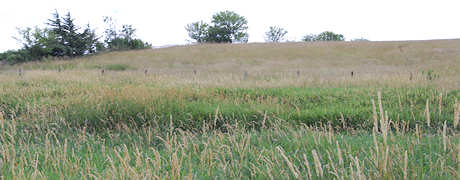
FAQ: Are landowners entering ground into the USDA Conservation Reserve Program anymore? Or are they putting their land that has the 10- to 15-year CRP contracts now expiring back into corn and soybean production?
Answer: Many landowners with Conservation Reserve Program contracts that are due to expire this fall are wondering whether to renew them. John Whitaker, state executive director for USDA's Farm Service Agency in Iowa, is encouraging farmers to stick with the program rather than pull that land back into corn and soybean production.

COMPETING FOR ACRES: As CRP contracts expire, a number of those conservation acres are being pulled back into corn and soybean production thanks to high grain prices instead of staying as grassland. But as the latest CRP general sign-up shows, some new land is accepted into CRP.
Staying seeded down to grass or tree planting is the better use for this highly erodible ground, he emphasizes. Plus, you have to consider the potential for a decline in corn and soybean prices in 2014 from the lofty levels of the past couple of years.
Whitaker announced on July 24 that FSA will accept 1.7 million acres offered nationwide under the 45th Conservation Reserve Program general sign-up that ended in June. The 1.7 million acres were selected from a pool of 1.9 million acres and 28,000 offers.
CRP program continues to have appeal to owners of environmentally sensitive land
In Iowa, FSA accepted 1,815 offers for nearly 50,000 acres of land, demonstrating CRP's continuing appeal as one of our nation's most successful voluntary programs for soil, water and wildlife conservation. Since 2009, USDA has enrolled nearly 12 million acres in new CRP land. Currently, there are more than 26.9 million acres enrolled on 700,000 contracts nationwide.
"CRP continues to help conserve our nation's resources, soil and water, and provides wildlife habitat," says Whitaker. "Iowa farmers participating in this most recent signup chose to protect environmentally sensitive land over high commodity prices, showing their commitment to the environment, clean water and wildlife. This demonstrates the importance of this conservation program and others administered under the current farm bill which is set to expire on September 30, 2013."
In addition to the general CRP sign up, the continuous CRP sign up is another option
In addition to the late July announcement regarding signup in the general CRP, over the last four years USDA has set aside significant acreage under CRP's continuous enrollment program to target habitat conservation on especially important lands, says Whitaker. For example, in March 2012 the administration allowed entry of 1 million acres of CRP to the CRP Continuous Enrollment Program to conserve wetlands, grasslands and wildlife. This year, farmers and ranchers have already offered more than 370,000 acres under Continuous CRP signup.
CRP is a voluntary program that allows eligible landowners to receive annual rental payments and cost-share assistance to establish long-term, resource-conserving covers such as grass and trees on eligible, highly erodible farmland throughout the duration of the 10- to 15-year CRP contracts.
Under the continuous CRP, farmers and ranchers plant grasses and trees in fields and along streams or rivers. The plantings prevent soil and nutrients from washing into waterways, reduce soil erosion that may otherwise contribute to poor air and water quality, and provide valuable habitat for wildlife.
CRP reduces nutrient losses and puts dollars into local communities
In 2012, CRP helped reduce nitrogen and phosphorous losses from farm fields by 605 million pounds and 121 million pounds respectively. CRP has restored more than 2 million acres of wetlands and associated buffers and reduces soil erosion by more than 300 million tons per year. CRP also provides $2 billion annually in payments to landowners, dollars that make their way into local economies, supporting small businesses and creating jobs, says Whitaker.
In addition, CRP sequesters more carbon dioxide than any other conservation program in the country, and also reduces both fuel and fertilizer use. Yearly, CRP results in carbon sequestration equal to taking almost 10 million cars off the road.
What criteria does USDA use to select bids for CRP entry?
How does USDA choose which land is accepted into the CRP and which is not? USDA selects the offers made by landowners for enrollment in the CRP based on an Environmental Benefits Index. The EBI is comprised of five environmental factors plus cost. The five factors are: (1) wildlife enhancement, (2) water quality, (3) soil erosion, (4) enduring benefits and (5) air quality.
For more information on the Conservation Reserve Program and other programs administered by FSA, contact your local FSA office or the website at www.fsa.usda.gov/ia.
About the Author(s)
You May Also Like




